Related Articles
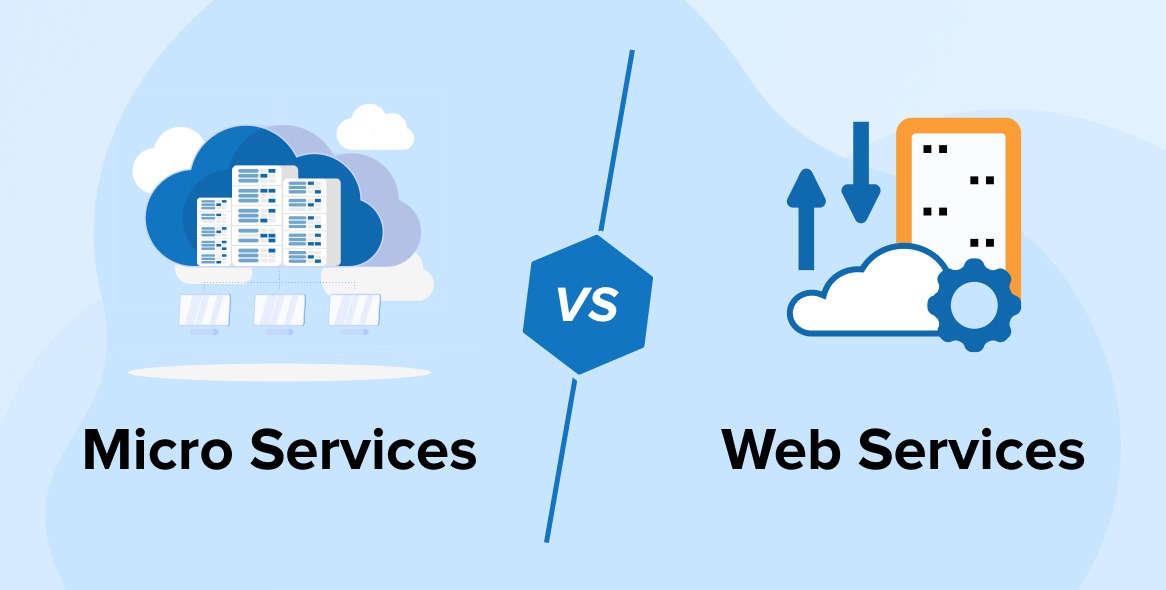
Microservices and Web Services are two different concepts of Application Development architecture, which can be differentiated from its layered architecture and development style. This blog gives more details about these concepts and the comparison of Web Services vs Microservices.
What is Web Service?
Web Service is a way to expose the functionality of an application to other application, without a user interface. It is a service which exposes an API over HTTP.
Web Services allow software applications developed in different technologies to communicate with each other through a common format like XML, Jason, etc. Web services are not tied to any one operating system , programming languages or user device software platforms. For example, an application developed in Java can communicate with the one developed in C#, Android, etc., and vice versa.
Web Service is a connection technology, a way to connect other services together into a Service Oriented Architecture (SOA) and also represents web application’s functionality.
There are mainly two types of web services – SOAP (Simple Object Access Protocol and REST (Representational State Transfer).
What is Microservice?
Microservice architecture is an independently deployable service modeled around a business domain having its own database. It is a method of breaking large software applications into loosely coupled modules, in which each service runs a unique process and communicates through APIs. It can be developed using messaging or event-driven APIs, or using non-HTTP backed RPC mechanisms.
Microservices are designed to cope with failure and breakdowns of large applications. Since multiple unique services are communicating together, it may happen that a particular service fails, but the overall larger applications remain unaffected by the failure of a single module. For ERP, CRM, automobile, banking and other financial services Microservices is the most suitable architecture.
Why Use Microservices and Web Services?
Web services support modules and feature independence, but microservices support independence at nearly all levels, including server instance, application, module, feature, and function. The more your independence, the easier it is to expand an application’s functional capabilities and give service to a wider user base.
Why Use Web Services?
Web services enable independence from monolithic programmes with no additional expense in terms of server instances, as the same number will be required. Although the time required to create apps using a web services architecture is little and adds expense to the project, it is worth the effort because every application will require minor modifications and fixes in the future. The web services enable you to expand the functionality of individual application modules without affecting the operation of other modules.
Why Use Microservices?
Microservices give greater freedom than web services but at the expense of development and maintenance. Microservices is an architectural style that enables you to scale the functional capabilities of your application and the user base it can support indefinitely. While microservices may operate on many server instances and utilise cross-region replication to minimise application latency, this software architecture also aids in disaster recovery management and load balancing by directing requests to replicas in different geographical areas.
Use-Case Representation
Let us understand these concepts with the help of an example of Online Shopping Center.
In figure-1: The Online Shopping Center Web Application is developed in Monolithic Architecture. In this application, there is one Web Service which communicates with web application and database. So this web service might be performing many functional tasks related to database operations.
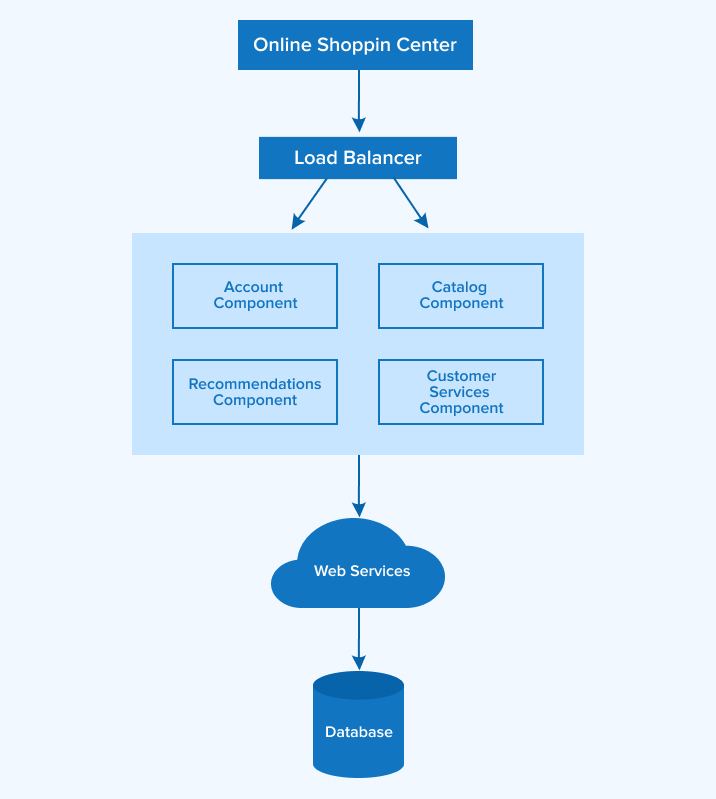
In figure-2: The Online Shopping Center Web Application is developed in Microservices Architecture. All the components of the web application are developed independently, single functional responsible, fine-grained clearly scoped services.
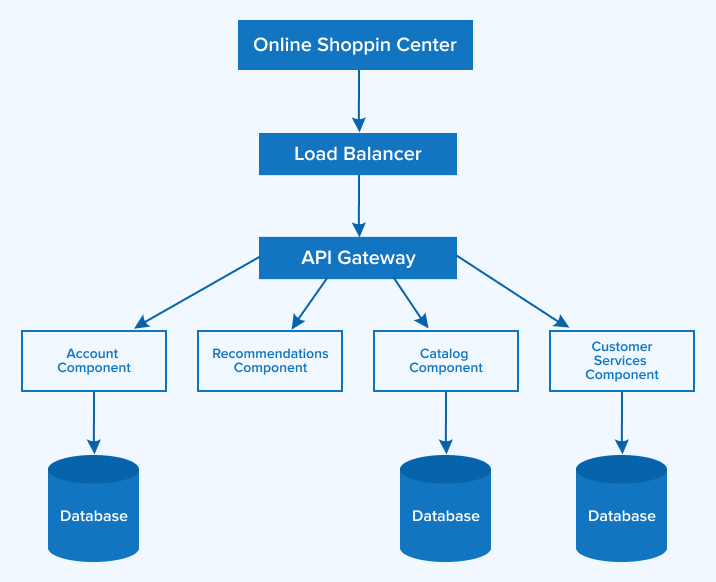
Web Services could be of any size, including large enterprise apps retrofitted with APIs that too many other apps depended on. Although “micro” in Microservices, the basic concept is that each service performs a single function.
For example, one of the largest eCommerce portal, Amazon, has migrated to Microservices. They get countless calls from a variety of applications, including applications that manage the Web Services API as well as the portal, which would have been simply impossible to handle for their old, two-tiered architecture.
Applications built as Microservices can be broken into multiple component services and this service can be a Web Service, which should run unique process and then redeployed independently without compromising the integrity of an application.
Microservices style is usually organized around business capabilities and priorities. Unlike a traditional monolithic development approach, where different teams have a specific focus on, say, UIs, databases, technology layers, or server-side logic, Microservices architecture utilizes cross-functional teams. The responsibilities of each team are to make specific products based on one or more individual services communicating via message bus. It means that when changes are required, there won’t necessarily be any reason for the project, as a whole, to take more time or for developers to have to wait for budgetary approval before individual services can be improved. Most development methods focus on projects: a piece of code that has to offer some predefined business value must be handed over to the client, and is then periodically maintained by a team. But in Microservices, a team owns the product for its lifetime.

In a monolithic service oriented architecture deployment, each small change meant that the entire monolith needed to be rebuilt and this, in turn, meant that re-builds weren’t happening as rapidly as they should.
A Web Service is a service offered by an application to another application, communicating with each other via the World Wide Web.
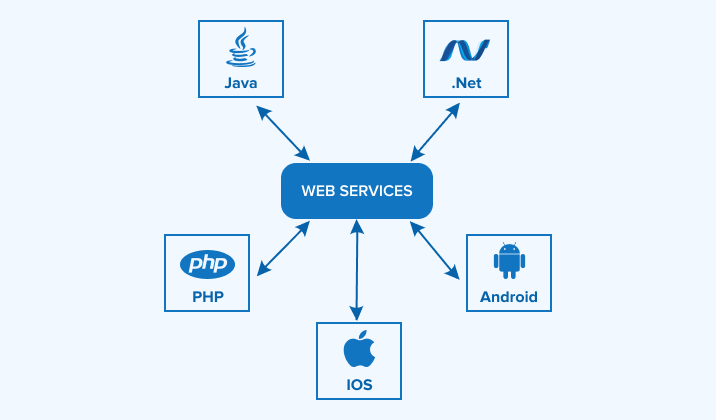
The Web Service typically provides an object-oriented web interface to a database server, utilized by another web server, or by a mobile application, that provides a user interface to the end user. Another common application offered to the end user may be a mash-up, where a web server consumes several web services at different machines and compiles the content into one user interface.
Web Services vs Microservices
Consider the following similarities and distinctions for Web Services vs Microservices:
Specificity of the Service
In terms of “service specificity,” a microservice performs a highly specialised service or job. For instance, the Facebook Messenger platform has a dedicated microservice for file attachment management. Utilize Facebook’s Attachment Upload API to have access to this capability.
By comparison, web services provide a single or a slew of services through a single application. This enables a web services architecture to organise access to an application’s many services. For an eCommerce application, one web service may provide ordering and payment services to customers, while another web service could provide inventory management services to non-customers. Even though these services are accessed via distinct web services, they may be part of the same application. Thus, web services can assist you in managing and controlling access to the many services that comprise an application.
Pluggability
Developers may quickly add, delete, and upgrade microservices and apps that comprise a broader application architecture using both microservices and web services application architectures. Because updates are quicker, simpler, and easier to accomplish without affecting the entire programme, this modular results in a more adaptable, agile design.
The APIs that link microservices provide additional versatility since they handle both HTTP and HTTPS and may build connections across message formats and protocols that are different.
On the other hand, web services do not support HTTPS, and the components that communicate with them must use the same message format and protocol. Having said that, an iPaaS such as DreamFactory may quickly resolve the message format and protocol constraints associated with a web service connection.
Cost-Effectiveness
Microservices are frequently deployed in containers. Because many containers may operate on the same kernel of the operating system, this saves costs by eliminating redundant operating system licences to run the different microservices that compose a bigger application architecture. Additionally, because APIs are universally connective, developers save time and money when building microservices API connections — because they save the work necessary to construct a hand-coded, point-to-point connection. Web services, as an HTTP-based presentation of APIs, also save time and money by eliminating the need for hand-coded, point-to-point integrations. Finally, the pluggable feature of both microservices and web services designs enables updates to be accomplished more quickly, simply, and economically.
Resilience
In microservices and web services designs, the failure of a single microservice or application has a lower probability of cascading failures affecting the rest of the ecosystem. In both situations, developers may use a circuit breaker design pattern to identify errors and prevent them from affecting other microservices or linked apps.
Language and Platform Agnostic
Developers may develop microservices or web services architectures by linking apps written in practically any programming language that operates on any platform. This provides developers with the flexibility to pick the most appropriate languages and platforms for the architecture’s many microservices, applications, and web apps. Additionally, they may easily build connections between premises and cloud, as well as cloud and cloud-to-cloud.
Smaller Development Teams
Microservices and web services both enable development teams to be simpler, more specialized, and easier to manage. Managers may delegate control of each web service or microservice to a smaller design team, enabling teams to work more autonomously and granularly on a particular component of the programme – without risk of code conflicts with other systems.
A distinction to be made is that web services developers must collaborate on common message formats and protocols used in web service integration.
Pros and Cons of Microservices and Web Services
How do web services and microservices compare in terms of benefits and drawbacks? Consider several key judgement criteria, such as fail-safety and customisation.
Fail-Safety
Both web services and microservices service enables fail-safe management of business applications with no performance degradation. They are the ideal substitutes for monolithic application structures since they operate independently yet with an integrated collection of components.
Microservice is associated with a distinct data source alongside web services. Due to the concurrent usage of an application’s many functionalities, its structure is capable of processing multiple user requests. This might result in an application collapsing if there is a high volume of active users.
A query may be managed by a single microservice or by a collection of microservices that collaborate. Additionally, because each microservice seems to have its own repository, the system’s load may be divided equitably among several databases. Although web services strike a reasonable mix between scalability and fail-safety, microservices scale far better.
Customization
Even if you choose to decentralise your programme, customization of the basic monolithic software structure is a factor. There will always be an issue with certain components that can be converted to microservices. These components will not function in isolation inside an existing functionality. It is preferable to reprogram them entirely. This is why providing such components as web services is a more difficult but superior approach.
Summing It Up
Finally, you may wonder which is the greatest option for your software development project. Here is an examination of which API representation tools perform the best in certain circumstances.
The fundamental determinant of the optimal architecture for any sort of project will always be the requirements. It is not professional to state unequivocally that one style of architecture is superior to another. The first consideration should be the application’s objective.
Because they do not require a network connection, small desktop and mobile applications do not employ microservices architecture or web services. In many instances, software development is less time consuming and may be completed quickly.
A WS is an excellent professional solution for more sophisticated software solutions that require network connectivity. Due to the connection with numerous other programmes, it performs effectively in larger and more sophisticated corporate application settings.
Microservices are optimal for smaller, well-divided web-based applications. Additionally, whether you are a designer building a web or mobile application, microservices are preferable since they provide greater control.
Considering all of the facts presented thus far, we can infer that microservices and web services serve distinct objectives and hence represent distinct architectural styles. In a more pragmatic way, a software solution can work well when microservices and web services are used concurrently.

Vishal Shah
Vishal Shah has an extensive understanding of multiple application development frameworks and holds an upper hand with newer trends in order to strive and thrive in the dynamic market. He has nurtured his managerial growth in both technical and business aspects and gives his expertise through his blog posts.
Subscribe to our Newsletter
Signup for our newsletter and join 2700+ global business executives and technology experts to receive handpicked industry insights and latest news
Build your Team
Want to Hire Skilled Developers?


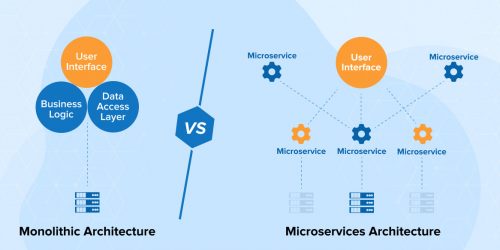
Well structured article with point to point details, Thank you for sharing!